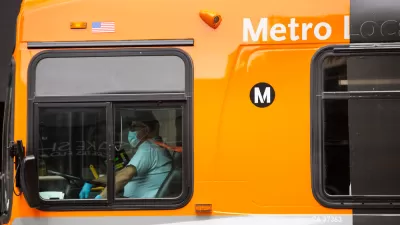Doug Failing, Executive Director of LA Metro's Highway Programs, proudly shares the agency's $700 million strategy for testing the value of public-private partnerships to finance and accelerate planned transportation upgrades.
With state and federal transportation funding slow, Los Angeles Metro and Caltrans are embracing public-private partnerships to finance and accelerate planned infrastructure projects. In an interview with The Planning Report, Doug Failing, Metro’s Executive Director of Highway Programs, outlines their Accelerated Regional Transportation Improvement (ARTI) program, a series of small projects through which the county transit agency plans to demonstrate its viability and desirableness as a partner with private enterprise.
Failing outlines the specific focus of ARTI (including the FR 710 gap between the 10 and 210, the high desert corridor from LA to San Bernadino, and the 710 freight corridor), the benefits of P3 funding, and what Metro and Caltrans expect to learn about project delivery under a P3 system. The move illustrates the financial expression of a public agency's reputation and best practices. As Failing notes, "We recognized at Metro that we don’t have a track record with the industry for large projects and that we need to develop something smaller, work through the decision-making processes, and gain some confidence with the public-private sector that Metro is a good partner and that they want to work with us."
FULL STORY: Metro's Doug Failing on County Transit Agency's Embrace of Public-Private Partnerships

Manufactured Crisis: Losing the Nation’s Largest Source of Unsubsidized Affordable Housing
Manufactured housing communities have long been an affordable housing option for millions of people living in the U.S., but that affordability is disappearing rapidly. How did we get here?

Americans May Be Stuck — But Why?
Americans are moving a lot less than they once did, and that is a problem. While Yoni Applebaum, in his highly-publicized article Stuck, gets the reasons badly wrong, it's still important to ask: why are we moving so much less than before?

Using Old Oil and Gas Wells for Green Energy Storage
Penn State researchers have found that repurposing abandoned oil and gas wells for geothermal-assisted compressed-air energy storage can boost efficiency, reduce environmental risks, and support clean energy and job transitions.

California's Canal Solar Projects Aim to Conserve Resources and Expand Clean Energy
California’s Project Nexus has begun generating electricity from solar panels installed over irrigation canals, with researchers and state agencies exploring statewide expansion to conserve water and boost clean energy production.

HHS Staff Cuts Gut Energy Assistance Program
The full staff of a federal program that distributes heating and cooling assistance for low-income families was laid off, jeopardizing the program’s operations.

San Antonio Remains Affordable as City Grows
The city’s active efforts to keep housing costs down through housing reforms and coordinated efforts among city agencies and developers have kept it one of the most affordable in the nation despite its rapid population growth.
Urban Design for Planners 1: Software Tools
This six-course series explores essential urban design concepts using open source software and equips planners with the tools they need to participate fully in the urban design process.
Planning for Universal Design
Learn the tools for implementing Universal Design in planning regulations.
Heyer Gruel & Associates PA
City of Moreno Valley
Institute for Housing and Urban Development Studies (IHS)
City of Grandview
Harvard GSD Executive Education
Salt Lake City
NYU Wagner Graduate School of Public Service
City of Cambridge, Maryland





























